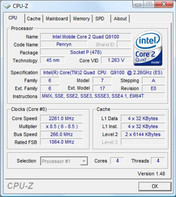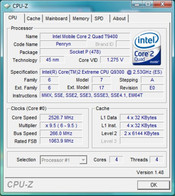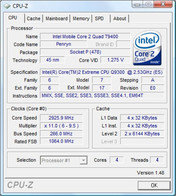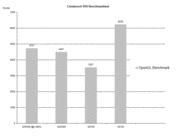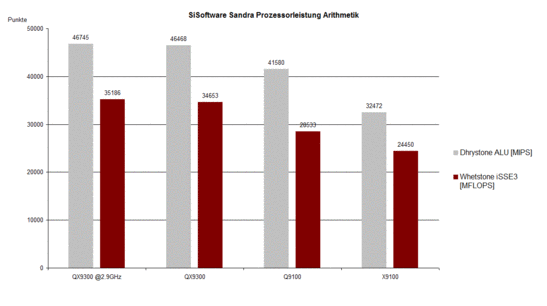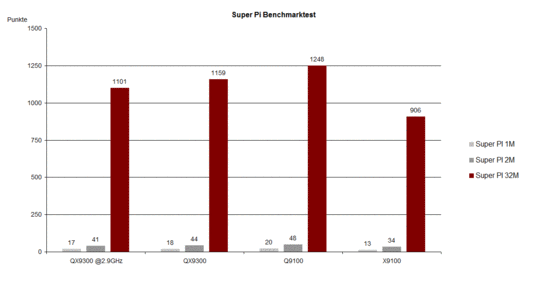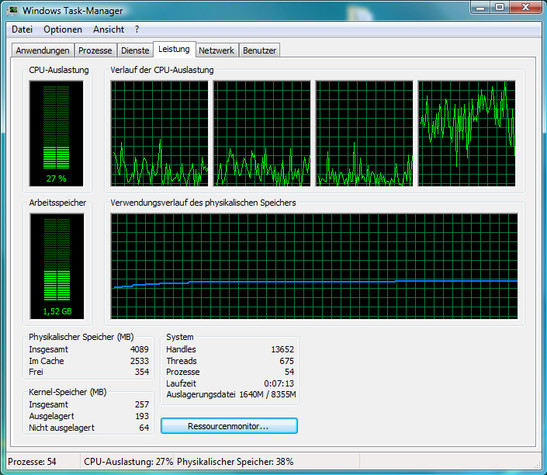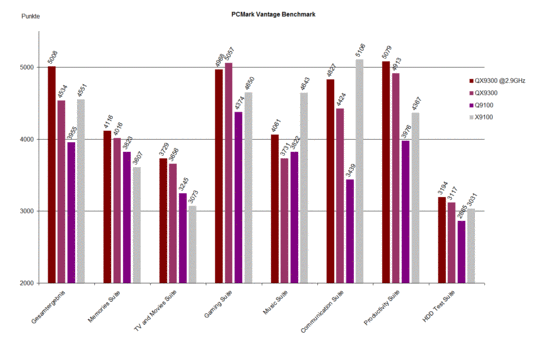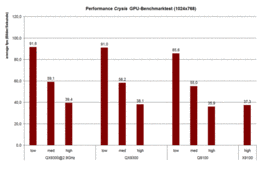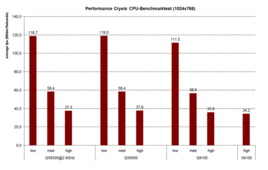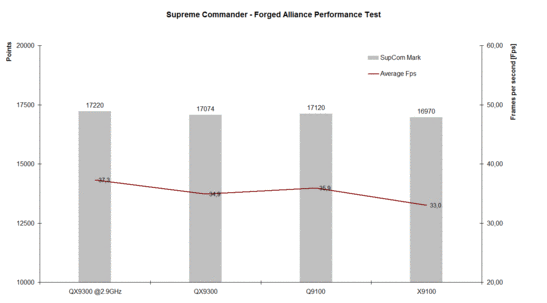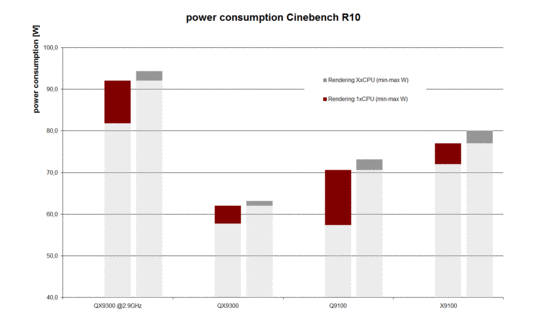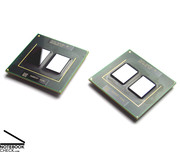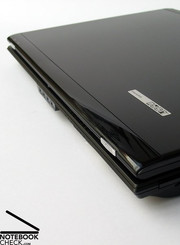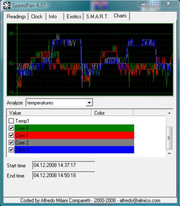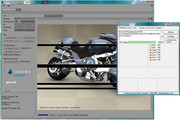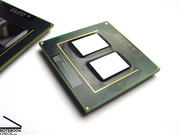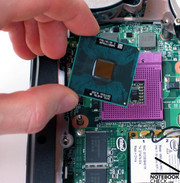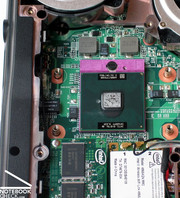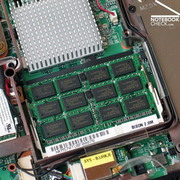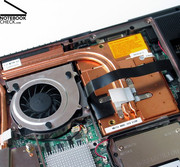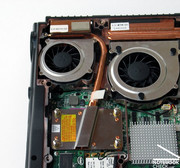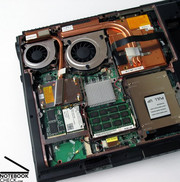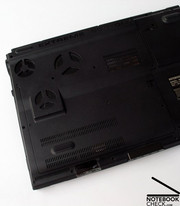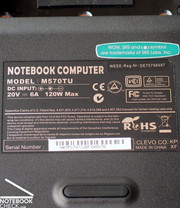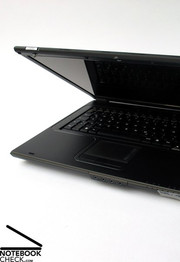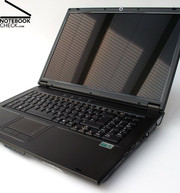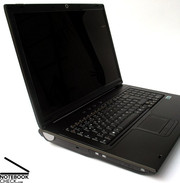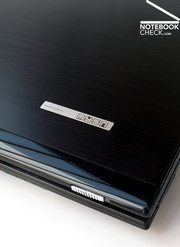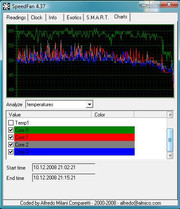Comparative Review of the Intel Core 2 Quad Notebook CPUs
Two times two equals four.
When Intel took its first step in the direction of dual-core processors, one thing was clear - the footrace to each individual MHz that had existed up to this time would be superseded by the number of cores on a chip. The quad-core CPUs are now the first step in this direction. After the desktop models, these are also available for notebooks.
Introduction
Barely three months after the launch of the Centrino 2 processors for notebooks, which we have already examined in an extensive comparative review, Intel is now bringing the next evolutionary step to the market. As the name Quad Core suggests, these offer, as the most important specification, a total of four processor cores on a single chip.
As can be recognized simply by looking at the chip, Intel's current Quad Core version is not just a simple 4-core processor, but comprises two dual core processors joined together on one chip. Because of this, there are four available cores each possessing its own L2 cache. Intel's sole competitor, AMD, has picked up on this idea, and is offering a quad core processor of its own with shared L2 cache, which should provide secondary performance advantages. But so far only for desktop computers.
Accordingly, the technical innovations of the new quad cores also turn out to be marginal as a result of this concept. The three quad core versions currently available for notebooks, the Core 2 Extreme EX9300, Core 2 Quad Q9100, and the Core 2 Quad Q9000 all possess a frontside bus (FSB) connection with 1066 MHz and a TDP value (thermal design power) of 45W. All of them are also based on the 45 nanometer production technology from Intel.
| Label | Clock Speed | L2-Cache | TDP | Price |
| QX9300 | 2.53 GHz | 12MB | 45 Watt | $ 1038.- |
| Q9100 | 2.26 GHz | 12MB | 45 Watt | $ 851.- |
| Q9000 | 2.00 GHz | 6MB | 45 Watt | $ .- |
With a TDP value of 45W, all of the current models still rely on the Intel Core 2 Duo Extreme CPU standard, which was the most powerful mobile processor for notebooks until now. Because of this, the new quad core chips can only be used in the larger notebooks for the time being, that is to say desktop replacements with ample cooling power. In the mean time, however, one can count on quad cores superseding the two core chips in compact notebooks, as well.
A mySN XMG7 notebook from Schenker serves as the test system, which provided both the test device and the respective processors. Further tests were done on the following devices with similar hardware configurations: Clevo M570TU barebone, 320GB 7200u/min Hdd;
As a reference for the dual core processors, the Intel Core 2 Extreme x9100 CPU from a comparable test system (Gefore 9800 GTX test) were drawn upon.
The following processors were tested:
Performance
In the first application performance test, with the help of the Cinebench Release 10 benchmarks from Maxon, the quad core processors already present an impressive indication of their performance capabilities. The Core 2 Extreme X9100 CPU, which was a clear leader in the last comparison test, was in the lower end of the rendering test results. In this test, the QX9300 CPU can score 10716 points, which places it around 28% over the X9100 CPU. The QX9300 chip, overclocked to 2.93 MHz for the purposes of the test, can even top the X9100 CPU by 43%, believe it or not.
In light of this, at least one thing is certain for multi-CPU supported rendering: the number of processor cores definitely affects the chip's clock rate.
In the arithmetic benchmark of the system analysis software Sisoftware Sandra, the results are equally pro-quad-core. In the Dhrystone (integer operations) and in the Whetstone (floating-point calculation) test, the tested quad cores have a distinct advantage over the X9100 dual core CPU.
In the SuperPi benchmark test, the apparent power advantage of the current quad cores from Intel can finally be relativized. In calculating the number Pi to an exactness of one, two, and 32 million decimal places, the Intel Extreme X9100 CPU with 3.06 GHz takes the lead. It completes lined-up calculations in the shortest time.
The overclocked QX9300 also lies altogether ahead of its competitor in the PCMark Vantage benchmark test from Futuremark, even though its superiority is not as great as in, for example, the single rendering tests of the Cinebench R10 benchmark test. While, with respect to the overall findings, the QX9300 CPU with 2.53 GHz and the Q9100 CPU with 2.26 GHz remain practically on the level with the X9100 Extreme CPU with 3.06 GHz, in the detailed analysis, serious differences can be observed.
Most notable are the results from the Music Suite and Communication Suite tests, in which the dual core CPU outperformed all of the quad cores without equal. The cause of this is perhaps, on the one hand, the slightly abnormal test system of the X9100 CPU and similarly the use of only a single core in the test.
That the advantage of the quad core CPUs in the Gaming Suite test does not automatically mean that it is performs much better with current games is evidenced by the following test of the power of the quad core processors with current computer games.
Gaming Performance
One should always bear in mind that the most important piece of hardware for current game performance is still the system's graphics card. In this regard, our test system possesses in its Geforce 9800M GTX graphics card from nVidia one of the most powerful mobile graphics cards currently available.
What does a powerful CPU actually bring to modern gaming? Now, apart from moving the pictures on the display, there is still be a series of functions that it would perform. Some of these are, for example, processing the computer AI (artificial intelligence), the input quality, computation of the gameplay, makeup of the scenes, quality of the input, etc., but also complex physics engines, which with new realistic games is gaining more and more importance. Here is exactly where the opportunity for multiple-core processors lies, since the individual cores can be allocated to specific functions and process them in parallel.
Unfortunately, these are still utilized insufficiently or not at all by a multiplicity of current games, even though many of them bejewel themselves with multi-core support.
Nevertheless, one can assume that in the near future, multi-core processing will gain importance in games as well, which will also increase the influence of the processor on the games' performance. With this in mind, a multi-core CPU would be an interesting investment even today.
The first game in our practical test for current games is the first person shooter Crysis. The performance with integrated demos for CPU and GPU was tested. For the comparison, the best value from each of four categories was selected.
With a resolution of 1024x768 pixels, a deviation of 5-10% in the GPU could be assessed within the quad core lineup. This also applies for the results of the CPU benchmark test.
In comparison to the Core 2 Extreme X9100 CPU (3.06 GHz), the overclocked QX9300 with an approximately equal speed of 2.93 GHz could only produce results around 5% better, which corresponds to about 2 frames/second with high details. If one allows for minimal but unavoidable imprecision in the measurements, this apparent advantage vanishes altogether.
Because of its expansive environment, the strategy game Supreme Commander - Forged Alliance also gives the processor a lot to do. Here, too, we draw on the game-integrated benchmark test for our CPU-comparison.
The test results for the quad core processors all-in-all lay extremely close together. This applies both for the total point count attained in the benchmark test as well as the average framerate during the course of the test. Surprisingly, the lowest result here comes from the QX9300 CPU with the normal clock rate of 2.53GHz. However, with 34.9 Fps, this lay just 2.4 frames (just under 7%) under the highest value from the overclocked QX9300 CPU. The X9100 dual core Extreme CPU from Intel, benched in a comparable system, delivered around 33.0 Fps in this category. This allows for, compared to the high-clocked quad core processor, an advantage of approximately 13%, or 4.3 Fps to be recorded.
Power Consumption
It appears clear that the new quad cores, whose basic principle is the unification of two dual core chips, cannot remain on the same level as a single similarly clocked dual core chip with regard to their power consumption. However, the reverse conclusion, that the power consumption therefore doubles, at least at maximum power consumption, is not really true.
For the mobile quad cores, far higher quality parts (with minimal power loss) are used in the so-called wafer (the base material for chip assembly), similar to the principle distinguishing the Core 2 Duo Pxxx and Txxx models.
With this, the chips' appetite for power can be contained, despite its many cores. The following graphic shows, for example, that despite the doubled number of cores, this brings the power consumption of our test system in the Cinebench R10 rendering test of the QX9300 and the Q9100 CPU down lower than that of the higher-clocked X9100 Extreme CPU. Not until the overclocking of the QX9300 did its power consumption shoot up.
What is extremely interesting here is also the higher energy needs observed for the lower-clocked Q9100 quad core CPU, which can be explained by the different quality of the chip's basic hardware. As a rule, for the Extreme variety of the Intel CPU, especially high quality hardware is used in order to allow sufficient leeway for overclocking of the CPU, which although not expressly allowed is unofficially tolerated.
Verdict
In our test, in addition to the QX9300 and the Q9100 CPU, we brought a chip overclocked to 2.93 GHz more precisely under the microscope. This was done exclusively for the purposes of the test, and the user himself is accountable for its reproduction.
Although in the course of the test, even with an overclocked CPU and intensive stress tests with our test system, no worrisome temperatures could be reached, there could be variations within chips of the same label because of the aforementioned wafer problem. As a consequence, the performance data and values with regard to power consumption can be affected, but much more problematic are the sizably higher heat emissions, which under some circumstances can overload the cooling system causing irreparable damage.
In the individual performance tests, the quad cores could earn overall a thoroughly good grade. The observed results are sufficient from the minimal advantages amounting to single-digit percentages up to the immense performance gains with multi-core optimized applications, rendering for example.
However, there are still a row of applications, especially computer games, with which the clocking of the chip is essential for good performance. Therefore the best results, not surprisingly, came from the overclocked QX9300 CPU, which combines a multi-core bonus with a high clock rate of 2.93 GHz, and consequently produces the best values in nearly all of the categories. The single letdown, as with nearly all CPU launches: the price. Intel still highly esteems its new top of the line mobile processor at a price of more than $1000.- US.
In any case, one thing is clear: the future belongs to the multi core processors. The only thing they still require is comprehensive support on the side of the software, and the single core chips that came this year will have absolutely no chance. Whoever can and wants to afford it can already be well served by the high-clocked quad cores, and he should keep in mind the rapid growth of software in this direction.
Intel has already announced the Core i7 Quad Core for the coming year, which, thanks to an integrated memory controller and a shared L2 cache, both should use up to 25% less energy and at the same time should work even more efficiently. We can't wait.
http://www.mysn.de/detail.asp?userid=bh9110427aa2469d7ghk2ejo2cl512974fi5ne7823jma6ceg10&KategorienOrder=010;020;050;090&bestellnr=adna0001Many thanks to the firm mySN Schenker-Notebook, who courteously provided the test machine. Here you can both configure and purchase the mySN M570TU.





